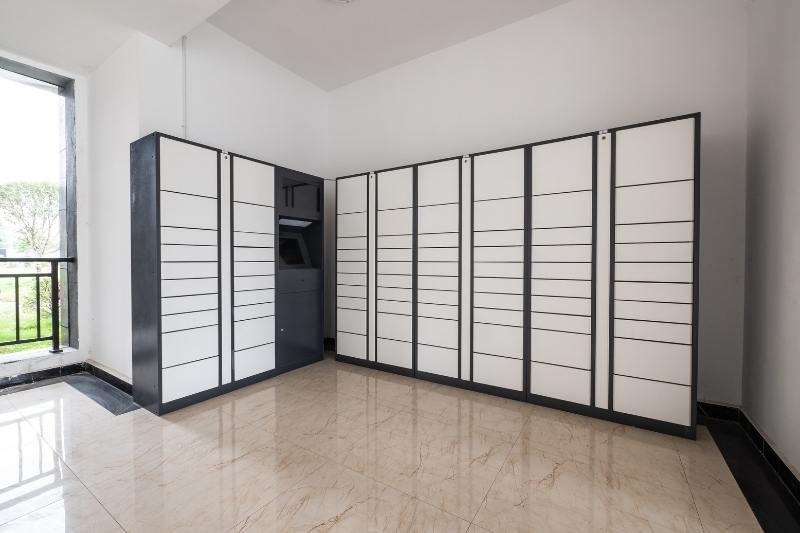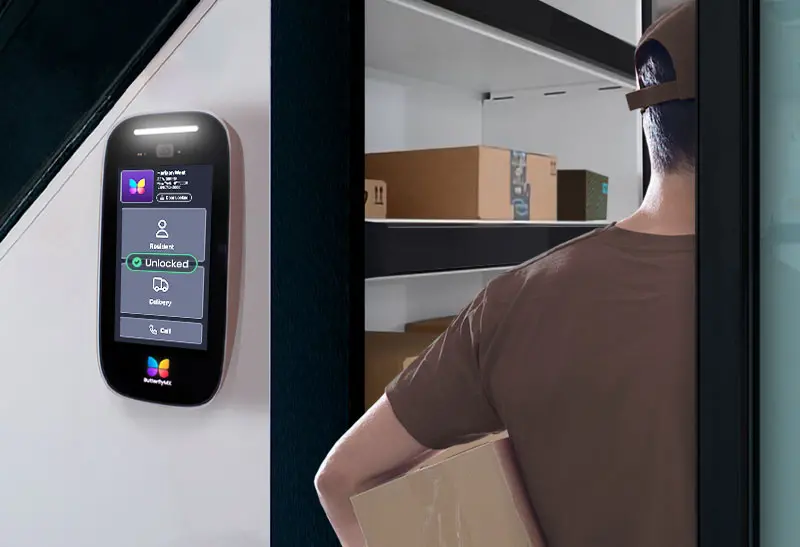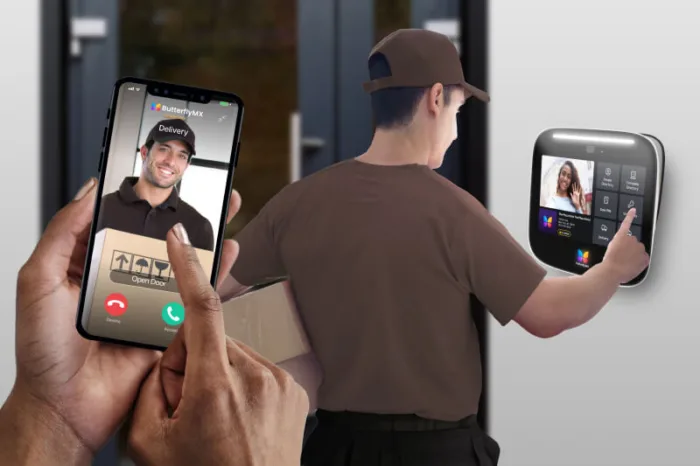Key takeaways:
- Rising package volumes make efficient delivery systems essential for multifamily buildings.
- Poor package management leads to courier issues, staff overload, and package theft.
- Some options include package rooms, lockers, off-site storage, management software, and delivery doors.
- Package rooms offer the best mix of security, convenience, and 24/7 resident access.

Every day, there are dozens of packages delivered to your building. So, you need a way to manage all those deliveries. From package rooms to package lockers, there are several package delivery systems designed to simplify the delivery management process for apartments and multifamily properties.
In this post, we explore the five most popular package delivery systems and discuss their pros and cons. We also outline why every apartment building needs a package delivery system, and highlight the best system for your property.
Read this post to learn:
- What is a package delivery system?
- Why you need a package delivery system
- Top 5 package delivery systems
- What is the best package delivery system for apartments?
- The ButterflyMX package delivery system
What is a package delivery system?
A package delivery system is a solution for buildings to manage the intake, storage, and distribution of packages delivered to residents of multifamily buildings.
When delivery carriers drop off packages at a multifamily property, they need a place to leave the parcels safely. Additionally, property staff needs a way to organize those packages and distribute them to residents. And residents need a way to pick up or receive their packages.
Without an apartment package delivery system:
- Couriers struggle to drop off parcels securely.
- Property staff spend several hours each week accepting, storing, and distributing packages.
- Residents suffer parcel theft or are stuck waiting for their packages.
Why you need a package delivery system
These days, every multifamily building needs a package delivery system to accommodate the growing number of packages being delivered. Online shopping is more popular than ever, and the ecommerce industry is only expected to grow. Plus, delivery rates skyrocket even higher during the holidays.
Managing deliveries at apartments involves accepting parcels from carriers, storing them somewhere, and distributing them to residents when they pick them up. Unfortunately, this process is tedious and time-consuming. However, package delivery systems alleviate the burden on property managers by streamlining and automating much (or all) of the process.
Saving time isn’t the only reason property managers love delivery solutions. If you don’t have a package delivery system, you might be surprised by the cost of package deliveries at your property. With an effective package management solution, your staff members’ salaries go toward more than just managing deliveries.
Finally, implementing a package delivery system improves the resident experience. Investing in the resident experience’ll ultimately retain more residents and renew more leases — which is great for your bottom line.
Top 5 package delivery systems
You know you need a solution to manage deliveries at your apartment — but what are your options? Read on to learn more about the five most common package delivery systems for multifamily properties.
The top five package delivery systems:
- Package room
- Package lockers
- Off-site package storage and drop-off
- Package management software
- Delivery doors
1. Package room
A package room is a designated room within a building where delivery carriers can drop off packages for residents to pick up at any time.
Usually, package rooms have controlled access so that only authorized couriers, residents, and building staff can enter. A video intercom with a mobile app controls the best package rooms. That way, residents can access the mailroom system through their smartphones, and couriers can access it by entering a PIN code. In addition, having a camera at the package room’s entrance adds an extra layer of security.
The benefits of a package room include:
- Reduce property staff’s time spent accepting, organizing, and distributing packages.
- Easy access and a quick delivery process for couriers.
- Residents can pick up packages any time — even after business hours.
- No need to spend money on lockers, storage containers, or additional staff members to manage deliveries.
Outside of installing an access control system, you only need shelving to set up a package room. Additionally, you can install security cameras and signs within the room to discourage package theft further.
How a package room works:
- When delivery carriers arrive at the package room, they gain access with an access credential — usually a PIN code — via the intercom or access control system.
- Some package room systems require couriers to mark which residents have received deliveries. This sends an automatic text or email notification to the resident, alerting them of the delivery.
- After they get inside, carriers leave packages in the room.
- Residents can pick up packages at any time.
Watch how the ButterflyMX package room works:
2. Package lockers
Package lockers are storage systems with several compartments that enable delivery couriers to drop off packages by placing each parcel in a separate compartment. Usually, package lockers are installed in a convenient spot within the building, such as the lobby.
Most package delivery lockers contain compartments of varying sizes. However, not all packages fit in even the largest compartments — bulky deliveries, such as furniture, won’t fit in the locker.
Some of the most popular smart lockers for packages are:
- Amazon Hub
- Package Concierge
- Luxer One
- Smiota
- Parcel Pending
- Package Nexus
How package lockers for apartment buildings work:
- A delivery courier accesses the building via a separate access control system, then initiates the package drop-off process at the electronic parcel lockers. Usually, this includes entering a PIN code.
- The courier selects the recipient, scans each package, and places them into separate locker compartments. When the compartment door shuts, it automatically locks.
- The package locker system sends a notification to residents who received a delivery. The notification usually includes a PIN number or QR code, which residents use to unlock the locker compartment.
- Residents can retrieve packages at any time.

3. Off-site package storage & drop-off
One of the newest package delivery systems on the market is the off-site storage and drop-off service. Companies such as Fetch have introduced this concept, where residents have packages delivered to a third-party facility and schedule a drop-off time that’s convenient for them. Fetch then delivers the package to the resident’s door at that time.
The benefit of an off-site or third-party package drop-off service is that property staff doesn’t have to manage deliveries. Additionally, these services help prevent package theft by ensuring items are delivered when residents are home to accept them.
However, one drawback of third-party delivery services is the delay in delivery. Since residents must wait for items to be delivered to two different locations, it can take longer than usual for them to receive their packages. Adding the extra delivery steps is also inefficient and not the most eco-friendly solution.
Comparison of package delivery systems
How third-party package storage & drop-off systems work:
- A building partners with a third-party package delivery company.
- When residents order items online, they have packages sent to the partner company, not to their apartment.
- Residents receive a notification after a package has been delivered to the partner company.
- After receiving the notification, residents schedule a time for the company to deliver their package to the apartment. Most third-party package delivery companies offer deliveries during nights and weekends.
- The company delivers the package, leaving it with the front desk staff or at the resident’s door.
4. Package management software
Package management software doesn’t provide a storage solution but instead strives to simplify the parcel intake and distribution process. This software — often in the form of an app — provides a way for property staff to scan packages, send automated delivery notifications to residents, and mark deliveries as complete.
Some popular package management software options include:
- Notifii
- PackageX
- ReceivingRoom
- ParcelTracker
A package management software platform may be a useful tool for building staff because it helps them keep deliveries organized and saves them the time of manually alerting residents of deliveries.
However, package management software still requires significant time and effort from staff. It also doesn’t provide any solution for storing packages. Additionally, residents must retrieve packages from staff, so they probably can’t pick up parcels after business hours.
How package management software works:
- Delivery carriers drop off packages with the front desk or building staff.
- On-site staff uses the software — often an app on a smartphone or tablet — to scan each package.
- The software reads each package’s label and automatically sends a push notification to each resident who has a package.
- Residents pick up packages from the front desk or staff member.
- Finally, staff logs the package as delivered and picked up in the software.
5. Delivery doors
A delivery door is a box built into the door or wall of a building, Most delivery doors are fitted with a keypad lock for additional parcel protection.
Delivery doors work in three steps:
- Delivery couriers arrive at your building.
- The couriers use the keypad to unlock the delivery box that’s retrofitted to your door or wall.
- Couriers drop the parcels inside the delivery door.
What is the best package delivery system for apartments?
The best package delivery system for apartments is a package room because it ensures successful deliveries while maximizing security and convenience.
Here’s why you should invest in a package room for your apartment building:
- Keep residents happy and enjoy higher resident retention rates.
- Staff have more time to focus on other tasks instead of spending hours on package management.
- Package rooms prevent package theft while ensuring easy access for couriers, staff, and residents.
In contrast to other package delivery systems, package rooms are more affordable, convenient, and secure.
With package lockers, you face the problem of large or odd-shaped packages that don’t fit in a compartment. In that case, couriers either leave packages at the front desk (which creates work for staff) or in the lobby (which leaves parcels susceptible to theft).
Package rooms are superior to third-party delivery services because they ensure faster deliveries and, therefore, happier residents. Plus, third parties may still leave packages in unsafe locations or need property access from staff.

The ButterflyMX package delivery system
If you’re ready to invest in the best package delivery system, get the ButterflyMX package room. ButterflyMX saves time and money for property staff while adding convenience for residents.
With ButterflyMX, you get both an access control and a package delivery system. With a video intercom at your property’s entrance and the door to the package room, you’ll ensure that couriers always have access to drop off parcels securely. So, your residents will never suffer missed deliveries or lost packages. Plus, residents get automatic notifications when they’ve received a delivery.
ButterflyMX makes deliveries simple with two key features:
- Delivery PINs. Property managers can assign unique delivery PIN codes to each carrier so that couriers always have a way to access the building. And staff can change or revoke delivery PINs at any time.
- Delivery passes. Residents can create and send delivery passes to any delivery provider for easy, secure, one-time access. To create a delivery pass, a resident simply generates a PIN code through the mobile app and pastes it in the delivery instructions upon check-out from an ecommerce provider.
Why choose ButterflyMX for your Package Room
Managing package deliveries can be a challenge, but ButterflyMX’s Package Room system offers a seamless, cost-effective, and space-saving solution. Unlike traditional package lockers, which have rigid compartments and limited space, a Package Room allows for more flexibility and convenience.
Here is why you should choose ButterflyMX:
- More space for deliveries. With a ButterflyMX Package Room, concern for compartment size is eliminated. Instead of being confined to predetermined locker sizes, deliveries can be placed freely in the package room, accommodating everything from small parcels to oversized packages.
- More affordable. Installing package lockers can be a significant financial burden, with even the smallest configurations costing thousands of dollars. In contrast, a ButterflyMX Package Room only requires a video intercom and basic shelving, reducing upfront costs and ongoing maintenance expenses.
- Simple setup. Unlike bulky lockers that take up valuable square footage, a Package Room can be set up in an existing space, such as a spare office or an unused back room. All that’s needed are shelves and a ButterflyMX intercom, allowing you to repurpose underutilized areas for package storage rather than dedicating space to a large, fixed locker system.
- Surveillance & audit logs. Security is a top priority for package management, and ButterflyMX’s Package Room system delivers built-in surveillance and audit logs. Every package room entry is recorded, providing you with a complete history of who accessed the room and when. This added layer of security helps reduce lost or stolen packages.
- Mobile access. Residents can retrieve packages effortlessly using the ButterflyMX smartphone app, which features a swipe-to-open function, eliminating the need for physical keys or access cards.








